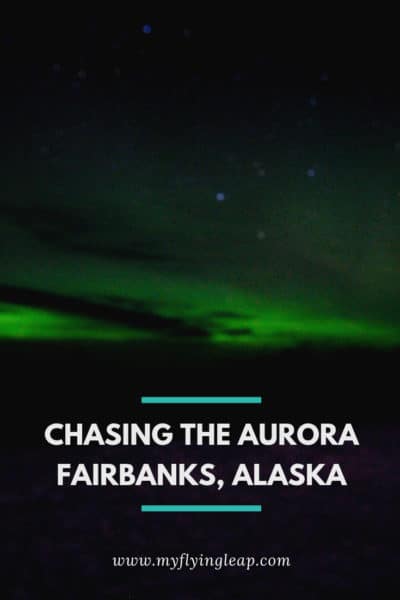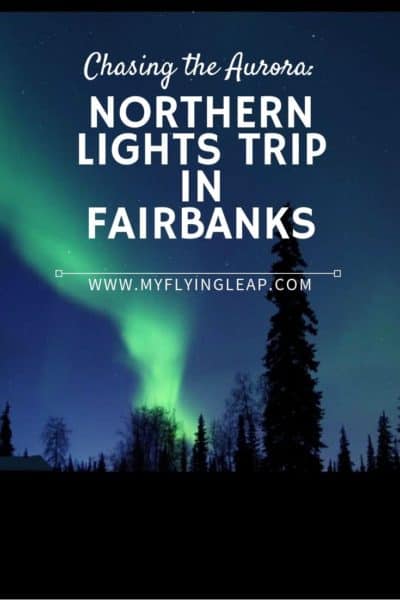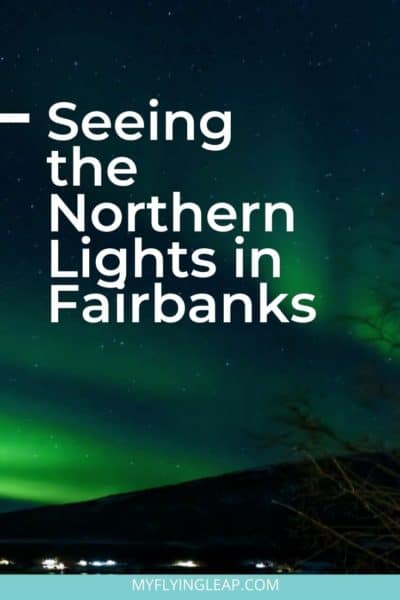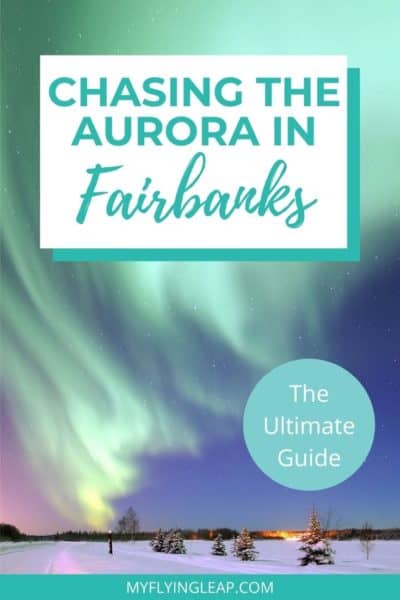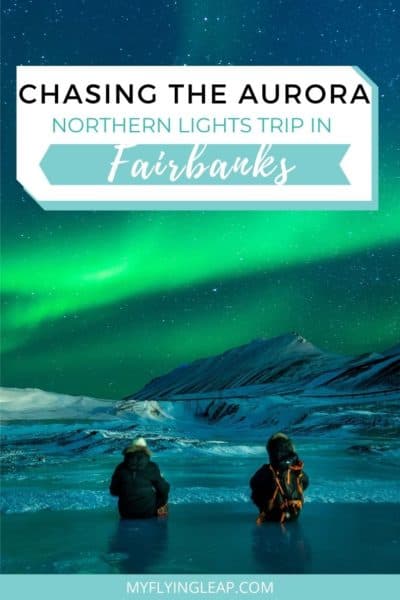Chasing the Aurora: Northern Lights Trip in Fairbanks
If you are looking for a great northern lights trip to one of the top destinations to see them, which also has lots of other things to do—look no further! Fairbanks, Alaska is the place for you.
Trying to see the northern lights is a favorite item when visiting Fairbanks, Alaska in the winter. However, there are a lot of other fun things to do. So, head on up there and check this off of your bucket list!
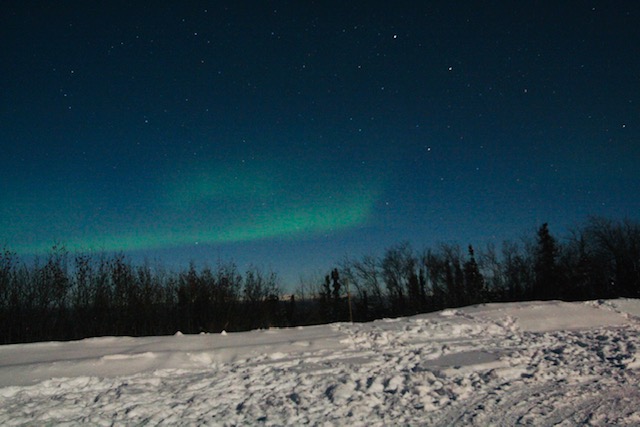
This post may contain affiliate links, which means I’ll receive a commission if you purchase through my links, at no extra cost to you. Please read full disclosure for more information.
What are the Northern Lights?
The northern lights, also called the aurora borealis, is a polar light that occurs in the northern hemisphere. These polar lights also happen in the southern hemisphere, where they are called aurora australis. They are a naturally occurring phenomenon.
The lights occur when charged particles emitted from the sun during a solar flare penetrate the earth’s magnetic shield and collide with atoms and molecules in the atmosphere. When these solar particles collide with oxygen, red and green auroras are produced. When they collide with nitrogen, pinks and purples are produced.
Altitude also affects the colors, and blues and reds generally occur up to 60 miles above the earth’s surface. Green occurs between 60 and 150 miles, and ruby red appears above.
This reaction occurs in the polar regions of the earth at an altitude of 40-400 miles from the earth in a zone called the “Auroral Oval.” These lights are most commonly seen between 60° and 75° latitude. However, they can reach 30° latitude or further.
Best Places to go in the World for a Northern Lights Trip
The best places to see the northern lights are in the countries that are the farthest north. These include the United States (Alaska, specifically), Canada, Iceland, Norway, Sweeden, Finland, and Greenland.
It is actually possible to be too far north to view the Northern Lights. The optimal viewing areas in some of these countries are in the southern regions.
The more you research, the more you will find varying opinions as to the best place to see the northern lights. There are variances based on various conditions so the answer can also change year-to-year and decade-to-decade.
It’s important to also consider what else there is to do in the area. While you are likely to be up much of the night to see the lights, you may want to choose where you go based on other factors as well. This includes what other things there are to do in the area.
Best Places to See the Northern Lights in the United States
Alaska is the northernmost state in the United States and is the best place to go for a northern lights trip if you wish to stay stateside. Though you can see the lights from anywhere with the right conditions, Fairbanks ranks as the top city in Alaska to go to.
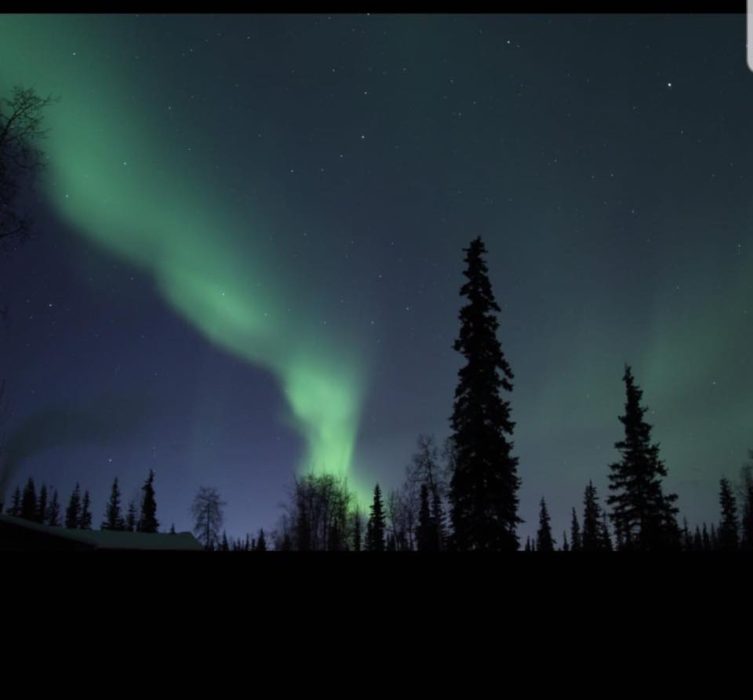
Fairbanks’ location is ideal for northern lights viewing for a number of reasons. First, it’s in the right location as it is under the “Auroral Oval,” a ring-shaped zone over the far north where aurora activity is concentrated. Second, Fairbanks has low precipitation and distance from coastal areas. This contributes to consistently clear nights.
Fairbanks also benefits from the University of Alaska Geophysical Institute. It conducts extensive research and tracks the Aurora, providing amazing data for forecasting in the area.
You May Also Like Top 21 Things to do in Fairbanks: The Ultimate Winter Guide
Best Places to go in Fairbanks
You can see the aurora from anywhere in the Fairbanks area with the right conditions. The best places to see the northern lights in the Fairbanks area, according to Explore Fairbanks are:
- Creamer’s Field Migratory Waterfowl Refuge is located 2 miles from downtown Fairbanks. [Map]
Chena Lake Recreation Area, located 17 miles from downtown Fairbanks, located just outside of North Pole, off of the Richardson Highway. [Map]- Cleary Summit [Map] There are multiple pull-out locations to go to depending on the volume of snow
on roads, but this map shows the location where we went. - Murphy Dome, located 25 miles from downtown Fairbanks on the west side, about a 40-minute drive. [Map]
- The Chena State Recreation Area, around 60 miles from downtown Fairbanks. [Map]
Explore Fairbanks provides some great information in terms of getting to each of these places. It even includes a tracker that shows the weather conditions at each location and the likelihood of seeing the aurora.
Resources and Information
The best websites for information for your northern lights trip to learn about the lights, to review forecasts to determine where to go to view them, and to get overall tracking information were:
- Explore Fairbanks
- University of Alaska Fairbanks Geophysical Institute
- Space Weather Prediction Center National Oceanic and Atmospheric Association (SWPC NOAA)
We did sometimes find conflicting information between them in terms of the forecast, however, each provided great information that was valuable.
The Best Months and Times for a Northern Lights Trip
Aurora season in Fairbanks is from August 21 to April 21. The best months are said to be February and March, followed by September. Temperatures are often higher in September making it a slightly more desirable time to visit. However, February and March are considered the best time to go for consistent viewing.
The aurora can only be seen when we have dark enough skies during what is known as the Aurora Season. Though it does occur during all times of the year. The best time to view it is usually between midnight and 3 a.m.
However, depending on conditions it could be seen from 90 minutes after sunset to 90 minutes before sunrise. If conditions are favorable, namely the sky is clear and dark enough, the aurora can be seen consistently more than three-quarters of the time.
Northern Lights Etiquette
It only takes one night of being bleary-eyed trying to stay awake until 3 or 4 a.m. trying to glimpse the northern lights before you learn some of what to do, and especially what not to do. You’re certainly not at your best or your most patient in the wee hours of the morning. One of the big things you learn about is light pollution.
Any lights cause light pollution. According to my google search means, “brightening of the night sky caused by street lights and other man-made sources. This has a disruptive effect on natural cycles and inhibits the observation of stars and planets.”
Light pollution is not your friend and will keep you from seeing the northern lights in their full glory. In some cases, it can keep you from seeing the lights at all. This includes light from:
- Your car: headlights, brake lights, running lights
- Flashlights and headlamps
- Electronic equipment like your phone, etc.
What Not to Do
On one night, a car pulled up very close to us and kept the headlights on. I finally went over to explain that you can’t see the lights well with any lights on and shining lights negatively impact pictures.
He turned off his headlights but kept his running lights on. Back I went and learned that it was a rental and he didn’t know how to turn them off. Further, he had no Wi-Fi on his phone to get instructions.
We spent a while pouring through the manual and checking out videos on my phone only to learn the guidance provided to turn off the running lights didn’t work. He did decide to move his car to another location so he wouldn’t ruin the experience of others. Yay!
Keep in mind that people who are staying up for most of the night several nights in a row may be very cranky. So, when they ask you nicely several times to please turn off the lights in your car, it’s advisable to do it!
What’s especially frustrating is that you go out of the city proper and to a remote area to view the lights. So, by having your car lights on, you’re ruining the experience for yourself and everyone around you.
And that reminds me—kindly don’t park right next to other cars. If there’s a big parking lot, give it some space so you don’t distract the others. Thank you. 🙂
Some Good Advice
A top suggestion is don’t walk in front of cameras. Some people use remotes and timers so you could get in their shots. Another bit of guidance is not to park too close to other people. Any of the light from inside your car can impact their viewing and their pictures.
And people also may try to catch a cat nap and you may disturb them if you are too close. We were surprised by how many times people pulled up right alongside us. You will see the same view from ten feet away, trust me!
What to Wear on a Northern Lights Trip
Layers, layers, and more layers! You will probably be outside in the cold for an extended period of time so bundle up and plan to wear lots of layers. I am from Arizona and expected to be cold.
I wore five layers on top (tank top, t-shirt, thermal shirt, sweater/sweatshirt, and a down jacket). On the
We also wore a scarf, thick gloves, and a warm hat. Additionally, we purchased hand and foot warmers at Fred Meyer, and they will be available at every grocery store. We didn’t find the foot warmers to get very warm so they weren’t very effective but the hand warmers really made a difference in our comfort.
In terms of fabrics, wool, fleece, and synthetic materials
You May Also Like Planning for a Northern Lights Vacation in Fairbanks
Tips for Photographing the Aurora
I won’t pretend to know anything about photography, particularly with an SLR or similar camera. I do know that when the aurora is weak, and even when it’s moderate, it can’t easily be picked up on an iPhone.
Interestingly, we found that even when it was considered moderate on all of the sites we were using for tracking the aurora it could barely be detected just with our eyes. We could see a haze of sorts but saw the glow that we expected when we took pictures of it.
My friend did have solid success photographing it with her SLR camera set up on a tripod. It wasn’t easy but she did a great job! This article has some great tips to photograph the aurora. This other article has some valuable information to share as well for how to get pictures of the aurora.
We did learn that the aurora can appear as a haze that almost looks like a cloud against the night sky. If you have a good camera, you can still take a picture and see the lights. It can be tough to focus but using a tripod can help immensely.

Some Tips for Aurora Hunting
Here are some of the things we learned from our experience.
- Make sure you have plenty of gas as you will have a lot of idling time heating up your car to stay warm during the night.
- Bring an insulated thermos for hot beverages.
- Be sure to know how to turn off your headlights and running lights before heading out for viewing to avoid pissing off the other people around you trying to get views and pictures.
- Check your car before you leave the airport to be sure you have a scraper or plan to get one as soon as you can.
- Buy lots of hand warmers.
- Wear lots and lots of layers. And then pack more.
- Be patient. The northern lights are never a sure thing and it can take time or days to see them.
Be Prepared for Better Viewing
Seeing the northern lights was a tremendous experience and a bucket-list item for my friend and me. It was one of the highlights of our trip and one of the things in Fairbanks that we enjoyed the most.
It’s important to do your homework in advance to be prepared and embrace the exhaustion of staying up all night. When you see the lights, it is so worth it!
You Might Also Like
- Dog Sledding in Alaska—A Top Thing to Do in Fairbanks
- Planning for a Northern Lights Vacation in Fairbanks
- Running Reindeer Ranch—The Best Thing to Do in Fairbanks
- Top 21 Things to Do in Fairbanks—The Ultimate Winter Guide
Like it? Pin it!
